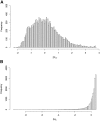Mutations in a Novel Cadherin Gene Associated with Bt Resistance in Helicoverpa zea
- PMID: 32179620
- PMCID: PMC7202007
- DOI: 10.1534/g3.120.401053
Mutations in a Novel Cadherin Gene Associated with Bt Resistance in Helicoverpa zea
Abstract
Transgenic corn and cotton produce crystalline (Cry) proteins derived from the soil bacterium Bacillus thuringiensis (Bt) that are toxic to lepidopteran larvae. Helicoverpa zea, a key pest of corn and cotton in the U.S., has evolved widespread resistance to these proteins produced in Bt corn and cotton. While the genomic targets of Cry selection and the mutations that produce resistant phenotypes are known in other lepidopteran species, little is known about how selection by Cry proteins shape the genome of H. zea We scanned the genomes of Cry1Ac-selected and unselected H. zea lines, and identified twelve genes on five scaffolds that differed between lines, including cadherin-86C (cad-86C), a gene from a family that is involved in Cry1A resistance in other lepidopterans. Although this gene was expressed in the H. zea larval midgut, the protein it encodes has only 17 to 22% identity with cadherin proteins from other species previously reported to be involved in Bt resistance. An analysis of midgut-expressed cDNAs showed significant between-line differences in the frequencies of putative nonsynonymous substitutions (both SNPs and indels). Our results indicate that cad-86C is a likely target of Cry1Ac selection in H. zea It remains unclear, however, whether genomic changes at this locus directly disrupt midgut binding of Cry1Ac and cause Bt resistance, or indirectly enhance fitness of H. zea in the presence of Cry1Ac by some other mechanism. Future work should investigate phenotypic effects of these nonsynonymous substitutions and their impact on fitness of H. zea larvae that ingest Cry1Ac.
Keywords: Cadherin; Cry1Ac; genome scanning; resistance; selection.
Copyright © 2020 Fritz et al.
Figures




Similar articles
-
Production and characterization of Bacillus thuringiensis Cry1Ac-resistant cotton bollworm Helicoverpa zea (Boddie).Appl Environ Microbiol. 2008 Jan;74(2):462-9. doi: 10.1128/AEM.01612-07. Epub 2007 Nov 16. Appl Environ Microbiol. 2008. PMID: 18024681 Free PMC article.
-
Mismatch between lab-generated and field-evolved resistance to transgenic Bt crops in Helicoverpa zea.Proc Natl Acad Sci U S A. 2024 Nov 19;121(47):e2416091121. doi: 10.1073/pnas.2416091121. Epub 2024 Nov 6. Proc Natl Acad Sci U S A. 2024. PMID: 39503848 Free PMC article.
-
Field-Evolved Resistance in Corn Earworm to Cry Proteins Expressed by Transgenic Sweet Corn.PLoS One. 2016 Dec 30;11(12):e0169115. doi: 10.1371/journal.pone.0169115. eCollection 2016. PLoS One. 2016. PMID: 28036388 Free PMC article.
-
Occurrence and Ear Damage of Helicoverpa zea on Transgenic Bacillus thuringiensis Maize in the Field in Texas, U.S. and Its Susceptibility to Vip3A Protein.Toxins (Basel). 2019 Feb 9;11(2):102. doi: 10.3390/toxins11020102. Toxins (Basel). 2019. PMID: 30744120 Free PMC article.
-
Resistance of Trichoplusia ni to Bacillus thuringiensis toxin Cry1Ac is independent of alteration of the cadherin-like receptor for Cry toxins.PLoS One. 2012;7(5):e35991. doi: 10.1371/journal.pone.0035991. Epub 2012 May 14. PLoS One. 2012. PMID: 22606242 Free PMC article.
Cited by
-
Genetic Knockouts Indicate That the ABCC2 Protein in the Bollworm Helicoverpa zea Is Not a Major Receptor for the Cry1Ac Insecticidal Protein.Genes (Basel). 2021 Sep 28;12(10):1522. doi: 10.3390/genes12101522. Genes (Basel). 2021. PMID: 34680917 Free PMC article.
-
Genome evolution in an agricultural pest following adoption of transgenic crops.Proc Natl Acad Sci U S A. 2021 Dec 28;118(52):e2020853118. doi: 10.1073/pnas.2020853118. Proc Natl Acad Sci U S A. 2021. PMID: 34930832 Free PMC article.
-
Characterization of Long Non-Coding RNAs in the Bollworm, Helicoverpa zea, and Their Possible Role in Cry1Ac-Resistance.Insects. 2021 Dec 22;13(1):12. doi: 10.3390/insects13010012. Insects. 2021. PMID: 35055855 Free PMC article.
-
Bacillus thuringiensis Cry1Ab Domain III β-16 Is Involved in Binding to Prohibitin, Which Correlates with Toxicity against Helicoverpa armigera (Lepidoptera: Noctuidae).Appl Environ Microbiol. 2021 Jan 4;87(2):e01930-20. doi: 10.1128/AEM.01930-20. Print 2021 Jan 4. Appl Environ Microbiol. 2021. PMID: 33127814 Free PMC article.
-
Cry1 resistance in a CRISPR/Cas9-mediated HaCad1 gene knockout strain of the Australian cotton bollworm Helicoverpa armigera conferta (Lepidoptera: Noctuidae).Pest Manag Sci. 2025 Feb;81(2):959-965. doi: 10.1002/ps.8500. Epub 2024 Nov 14. Pest Manag Sci. 2025. PMID: 39544011 Free PMC article.
References
-
- Benjamini Y., and Hochberg Y., 1995. Controlling the false discovery rate: a practical and powerful approach to multiple testing. J. R. Stat. Soc. Series B Stat. Methodol. 57: 289–300.
-
- Benedict J. H., Altman D. W., Umbeck P. F., and Ring D. R., 1992. Behavior, growth, survival, and plant injury by Heliothis virescens (F.)(Lepidoptera: Noctuidae) on transgenic Bt cottons. J. Econ. Entomol. 85: 589–593. 10.1093/jee/85.2.589 - DOI
Publication types
MeSH terms
Substances
LinkOut - more resources
Full Text Sources
Miscellaneous
